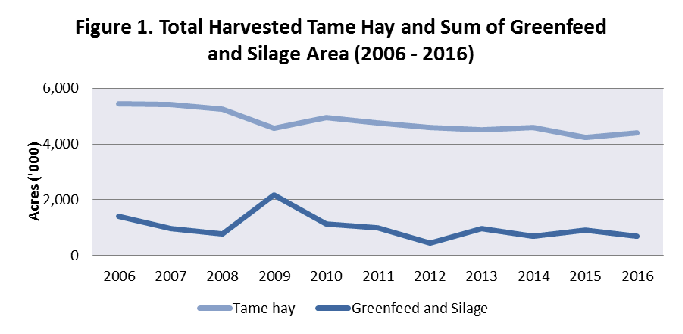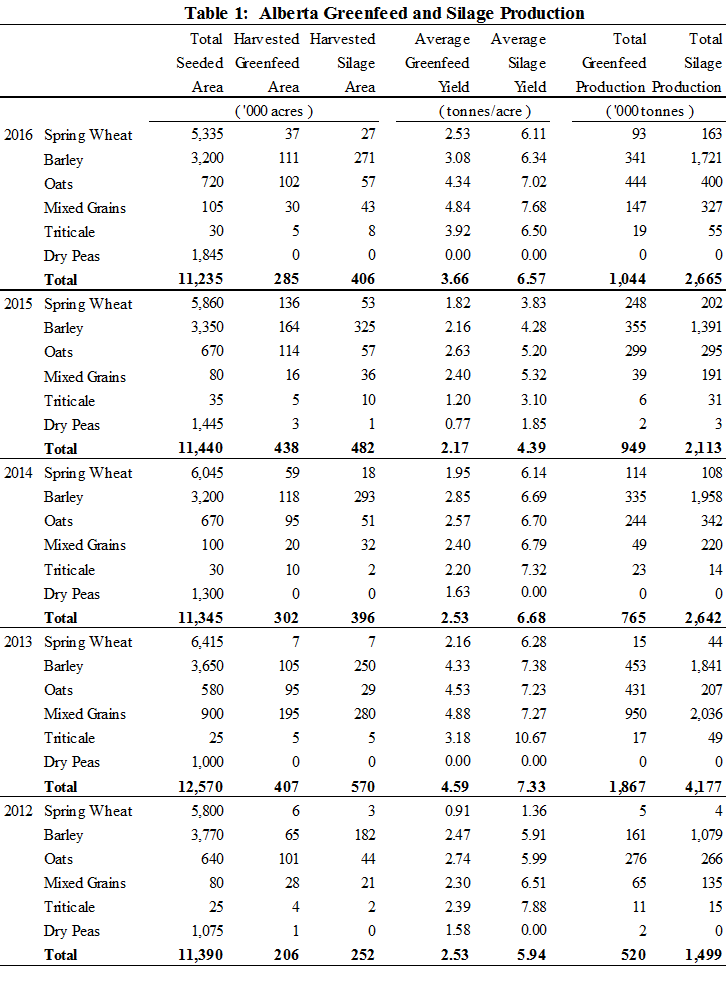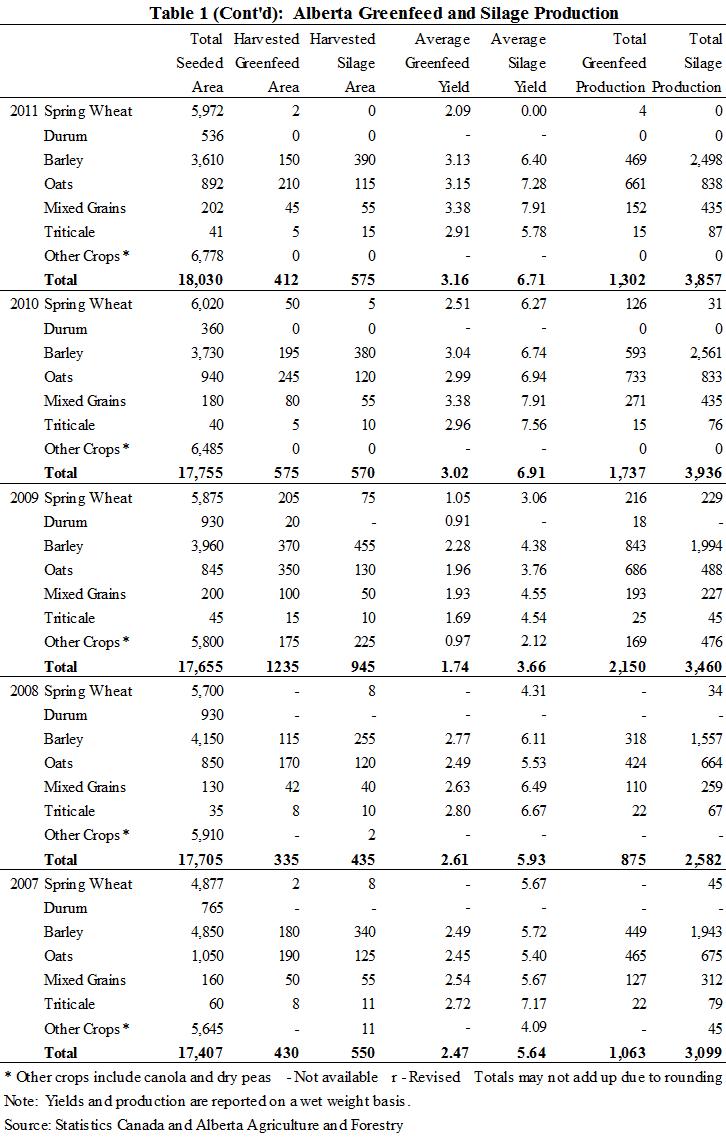| | .
Purpose of survey | 2016 production
.
Alberta 2016 Greenfeed and Silage Production Survey Results
Purpose of Survey
Greenfeed and silage production statistics for Alberta are not available from Statistics Canada or any other source, despite the fact that producers in the province harvest significant acreages of annual crops for greenfeed and silage every year. To fill this data gap and meet client needs, the Statistics and Data Development Section of Alberta Agriculture and Forestry (AF) initiated a greenfeed and silage production survey in 2002. Since then, the survey has been conducted annually, to develop selected statistics for the forage industry.
As in previous years, the 2016 survey was done in partnership with Agriculture Financial Services Corporation (AFSC). The survey collected data on greenfeed and silage acreage, yields and production at the municipal level. The information was then used, along with input from AF specialists to develop provincial estimates. Just to note, the yield and production estimates in this report are on a wet weight basis.
Alberta 2016 Greenfeed and Silage Production
Although the 2016 crop season in Alberta started with a dry spring, crop growing conditions were mainly favouable for producers. Precipitation early in the season was appropriate and timely to produce above average yields. However, persistent wet and cold weather conditions from mid-August to November delayed the harvest season which was one of the longest on record. The excessive soil moisture affected crop quality including tame hay.
The crop season started with poor conditions for pastures. As of May 3, conditions were reported as 30 per cent poor, 34 per cent fair, 32 per cent good and four per cent excellent. The poor to fair situation remained dominant in May but changed to eight per cent poor, 38 per cent fair, 41 per cent good and 13 per cent excellent as of May 31. After this, pasture conditions remained generally good to excellent for the rest of the season. As of August 23, pasture conditions were reported as three per cent poor, 18 per cent fair, 61 per cent good and 18 per cent excellent. However, too much precipitation and excessive soil moisture from the end of August caused pasture conditions to deteriorate somewhat. As of October 25, pasture conditions were reported as nine per cent poor, 25 per cent fair, 56 per cent good and ten per cent excellent.
Based on the Statistics Canada report “Production of Principal Field Crops, December, 2016”, forage production (fodder corn and tame hay) for Alberta in 2016 rose 53.8 per cent from last year, to 9.4 million tonnes. The marked increase was attributed to higher production for fodder corn and tame hay. Fodder corn production jumped 38.2 per cent to 1.5 million tonnes due to an increase in both harvested areas and increased yields. Tame hay production was estimated at 7.5 million tonnes, up 57.3 per cent from 2015, and 4.7 per cent above the 10-year average (2006-2015). Driving most of this gain was a significant increase in yield. The average yield of tame hay increased 53.8 per cent to 2.0 tonnes per acre, while harvested area was up 4.0 per cent to 4.4 million acres.
In 2016, Alberta producers seeded an estimated 11.2 million acres of spring wheat, barley, oats, mixed grains, triticale and dry peas (see Table 1). About 91.2 per cent of this area was harvested as grains and oilseeds (in line with 2015, and down 1.6 per cent from the 5-year average), 6.1 per cent as greenfeed and silage (down two per cent from 2015 and in line with the 5-year average) and 2.3 per cent was abandoned (up 2.3 and 2.2 per cent from 2015 and the 5-year average).
Total area harvested for greenfeed and silage declined in 2016 to 691,171 acres, down 24.9 per cent from 2015 (See Figure 1). Greenfeed harvested area dropped 34.9 per cent to 285,227 acres, while silage acreage decreased by 15.7 per cent to 405,954 acres. Compared to 2015, producers harvested less greenfeed and silage mainly because of the significant increase in hay production as well as grazing their swaths due to the long, cold and wet harvest season. Just to caution, data for 2016 survey was collected in Mid-October, when farmers still did not have a very good idea about the harvest season, and as such, these could be a revision in the acreages.

Source: Alberta Agriculture and Forestry
Receiving appropriate precipitation at the right time over the crop season contributed to high yields for all crops. The provincial average yield for greenfeed (selected crops) was 69.0 per cent higher than in 2015 and estimated at 3.66 tonnes per acre. Greenfeed barley was estimated to average 3.08 tonnes per acre, up 42.4 per cent, while spring wheat averaged 2.53 tonnes per acre, up 38.8 per cent. Greenfeed oats increased 64.8 per cent to 4.34 tonnes per acre. The estimated provincial average yield for silage (selected crops) increased 49.7 per cent to 6.57 tonnes per acre. The yield for spring wheat silage jumped 59.5 per cent to 6.11 tonnes per acre. Barley silage yield was up 48.1 per cent to 6.34 tonnes per acre, while oats increased 35.1 per cent to 7.02 tonnes per acre, mixed grain up 44.5 per cent to 7.68 tonnes per acre and triticale increased 109.7 per cent to 6.50 tonnes per acre.
Despite a 34.9 per cent decrease in the total harvested area for greenfeed, total production for greenfeed increased 10.0 per cent in 2016, due to a 69.0 per cent increase in greenfeed yields. The production for greenfeed barley was 340,507 tonnes (down 4.1 per cent from 2015), while for oats, it was estimated at 443,977 tonnes (up 48.6 per cent).
Total silage production was estimated at 2.7 million tonnes, up 26.2 per cent from 2015. This increase was the result of a 49.7 per cent increase in the average provincial yield for silage which more than offset a 15.7 per cent decline in harvested area. Barley silage production was estimated at 1.7 million tonnes (up 23.7 per cent from 2015) and oats at 399,899 tonnes (up 35.7 per cent).
The major crops harvested for greenfeed and silage in 2016 were barley and oats, although many acres of spring wheat, mixed grains and triticale were also included. Barley accounted for 38.8 per cent of the provincial total harvested greenfeed area, while oats represented 35.9 per cent. Spring wheat accounted for 12.9 per cent and mixed grains accounted for 10.7 per cent. The remaining 1.7 per cent of total harvested greenfeed area was from triticale. In terms of harvested silage area, 66.8 per cent of the provincial total was barley, 14.0 per cent oats, 6.6 per cent spring wheat, 10.5 per cent mixed grains and 2.1 per cent triticale.
Estimates of greenfeed and silage production in Alberta for previous years, dating back to 2007, are also shown in Table 1.
For further information on the survey results, please contact:
Ashan Shooshtarian, Crop Statistician
Alberta Agriculture and Forestry
Economics and Competitiveness Branch
Statistics and Data Development Section
Telephone: 780-422-2887
Fax: 780-427-5220
Email: ashan.shooshtarian@gov.ab.ca


 |
|